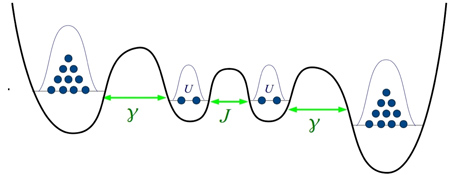Electrical Transmission at the Atomic Level
1 April 2014

Source: Wimberger
In a study on the transport of atoms in ultracold gases, a team of physicists led by Dr. Sandro Wimberger has developed a new approach to how signals might be transmitted at the atomic level. This could be especially important for realising logic structures with strictly defined functions on the basis of individual atoms, which in turn could find application in transistors or diodes. The research work in the innovative field of atomtronics is being done at the Institute for Theoretical Physics at Heidelberg University. The researchers are attempting to gain a fundamental understanding of quantum mechanical effects as compared to conventional electronics.
New experimental techniques allow targeted control of ultracold atomic gases – and ergo the bottom-up creation and study of logical components. Dr. Wimberger’s working group is studying the transport of individual atoms through a chain of so-called potential wells. “At an entirely different order of magnitude, imagine an empty egg carton in which the eggs ‘wander’ from one dimple to the next across the entire carton,” explains the Heidelberg physicist. In these experiments, the atoms behave coherently, meaning they follow the same fixed rule during dynamic transport. In this instance, their behaviour is completely quantum mechanical over the entire chain of potential wells. Dr. Wimberger adds that at the same time, however, different atoms interact with one another, which can affect transport from one well to the next.
The principle is similar to the flow of electrons in a solid state body to which electrical voltage is applied. In this case, the Heidelberg scientists are working with bosonic atoms from a large particle reservoir coupled to a lattice of potential wells. Via the lattice chain, individual bosons flow from the larger into a smaller particle reservoir, generating a particle current in the process. “The atomic current depends on the properties of the particle reservoir, but especially on the interactions between the atoms,” states Anton Ivanov, the study’s lead author and formerly a member of Dr. Wimberger’s working group. If the interaction is weak, the atomic current flow is directly proportional to the difference in the number of particles between the two reservoirs. Therefore, it increases linearly with the difference in the number of particles – which is analogous to the voltage in an electrical circuit. If their interaction is strong, the atoms intersperse and block the flow of electricity until it comes to a complete halt.
In their study, the Heidelberg researchers used an analytic approach that was largely confirmed through numerical calculations. The results of their research were published in the “European Physical Journal”.

